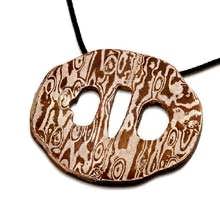
Tsuba et mokumé
Un symbole d'unité et de courage
Apporte l'unité et le courage immense dans votre vie
The Tsuba is actually the hand shield from the Samurai swords. In the 17-18th century when there were periods of peace in Japan, the Tsuba, like the Samurai sword itself, became a decorative symbol used in various ceremonies. Skilled Artists and jewelers produced breathtaking models according to demand. The Tsuba reflected Japanese tradition and included traditional Japanese geometric models. The Tsubas included images from nature in accordance with Haiku poetry that describes a moment in time and traditional symbols that reflect courage, fidelity, diligence, and clarity of thought.
The Tsubas from my point of view represents the symbol of “The Diamond sword” from Zen philosophy. The very sword that metaphorically cuts the world of illusion, the superfluous thoughts and feelings that mislead the human being and prevent him from seeing and accepting the reality as it is.
The Tsuba is a symbol of courage, fidelity, and diligence.
The Mokume Tsuba
The Mokume Gane technique was developed in 17th century Japan on the heels of the existing layered metal technique in the “katana” samurai swords. The technique allows the forging of metal that actually looks like wood. The meaning of the word Mokume Gane means the metal that looks like eyes in wood.
Every Mokume jewel is a special and exclusive creation that is purely handcrafted. The process of creation contains within it also the kabbalistic concept of “intentions” meaning the concentration of consciousness during the process and also the yogic concept of “Samadhi” meaning the ability to create things on the physical plane by focusing the consciousness.
The pendant is made of brass and copper.